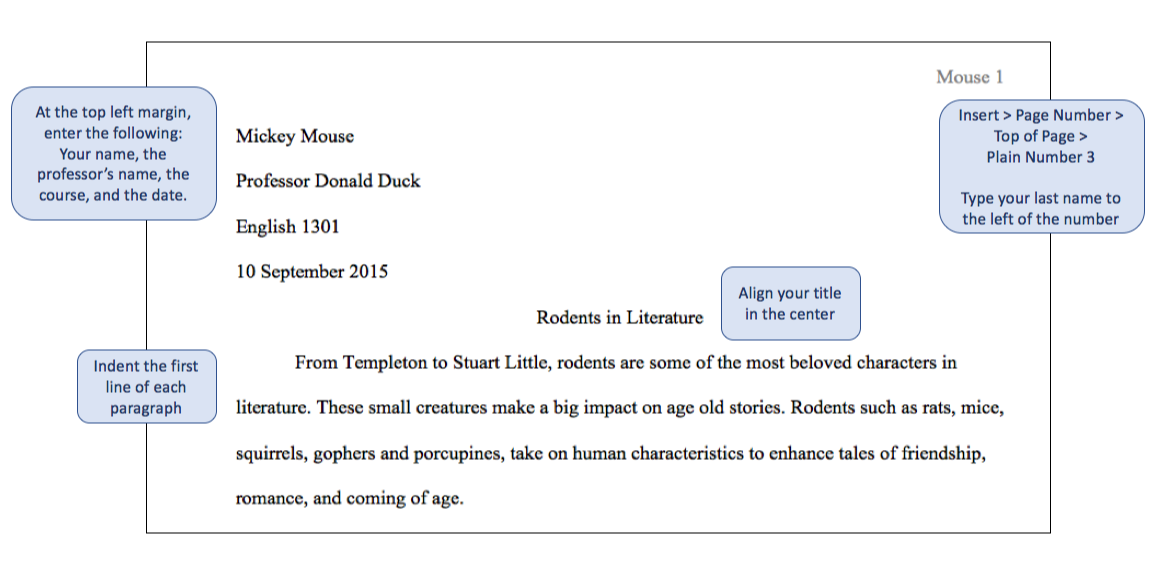MLA Style belongs to the guidelines appointed by the Modern Language Association for writing essays. It tells you how to provide your headings for any type of essay where MLA Style is required. These guidelines also help students structure other parts of the paper, including headers and title as well.
Structuring the Opening Page
The cover page is not required when you’re using MLA format. You may ask: “what to do then?”. On the first page of your essay, you have to provide a clear identification in the upper left-hand corner to identify your personality. It should contain:
- Student/Author Name;
- Instructor’s Name;
- Class Name/Information;
- Your Paper’s Due Date.
Settings:
- Font: if you don’t have strict requirements, then choose easy-to-read font like Times New Roman. Use it throughout your whole paper.
- Font Size: set the font size to be 12 including the title.
- Margins: 1-inch for top/bottom/right/left.
- Double-space: double-space throughout the paper.
Format the Title
The title usually goes line below the identification part and one single-spaced line above the first line of the paper itself. Do not use underlining, quotation marks or italics. The title should be placed in the center of the page and capitalized. 
The standard requirements for capitalization in MLA style are the following:
- Capitalize the first letter of every word except for articles (“a”, “an”, and “the”), coordinating conjunctions (“and”, “for”, “or”, “yet”, “so”, “nor”, and “but”), and prepositions (words like “in”, “on”, “above”, “throughout”, “to”, “below”, “above”, etc.);
- The first word of the title is always capitalized, even if it’s an article or preposition.
Double-space the Document
The whole doc should be double-spaced. It means that there must be a space between the lines of your information and between the title and the text. Use single spaces after the period or other concluding punctuation mark. Don’t manually enter the spaces into your document, it’ll make the doc look a little bit weird.
Provide the Header
The header usually goes throughout the entire paper, so each page is tagged. The first header often (but not always) emerges on the second page. It includes the author’s last name and the page number placed to the right of the surname.
Writing Section Headings
Headings and subheadings help organize and structure your paper. MLA suggetions for headings formatting are not obligatory but they help the writer to improve the quality of the material. Students can be not required to involve section headings for their paper. To be sure whether to do it or not just ask the teacher or check assignment guidelines. If you are really demanded to do it, then make sure that you follow all special requirements which were provided to you.
Separate Your Document into Main Sections
First of all, it’s important to divide the paper into the sections in order to include headings appropriately. Each part should contain and develop its main idea. Actually, sections are more used in large papers, e.g. 5-10 pages or even more. If your essay is short enough, you certainly don’t need the headings. Note: if the paper is very lengthy, it would be better here to split all section into sub-sections. In this case, you should add the subheadings.
Think of Style
MLA format doesn’t point how your headings should be formatted. You have the incredible opportunity to determine by yourself. You can bold the main headings and highlight the subheadings to make your document look neat. But if you want to stay formal, here are the standard format requirements:
Level Formatting
1. heading: bolded, flush/aligned with the left margin
2. heading: italicized, flush/aligned with the left margin
3. heading: bolded, centered on the page
4. heading: italicized, centered on the page
5. heading: underlined, flush/aligned with the left margin
Note: the word-processing software often has built-in heading styles.
Name Each Section Correspondingly
Name each section with the proper title. Capitalize the heading and try to use phrases of the same lengths. Bear in mind that the title should describe the essence of the section. This will help readers understand the developed idea coherently. Choose headings that will split your topic logically, i.e. don’t forget about such elements as chronology, geography or steps of a process.
Balance
No prominent heading level should have only one instance. For example, if you have one level 1.1, you need to have a second level 1.2 heading. Each heading should also provide the text below. Otherwise, your paper would be considered as a plan or an outline.


